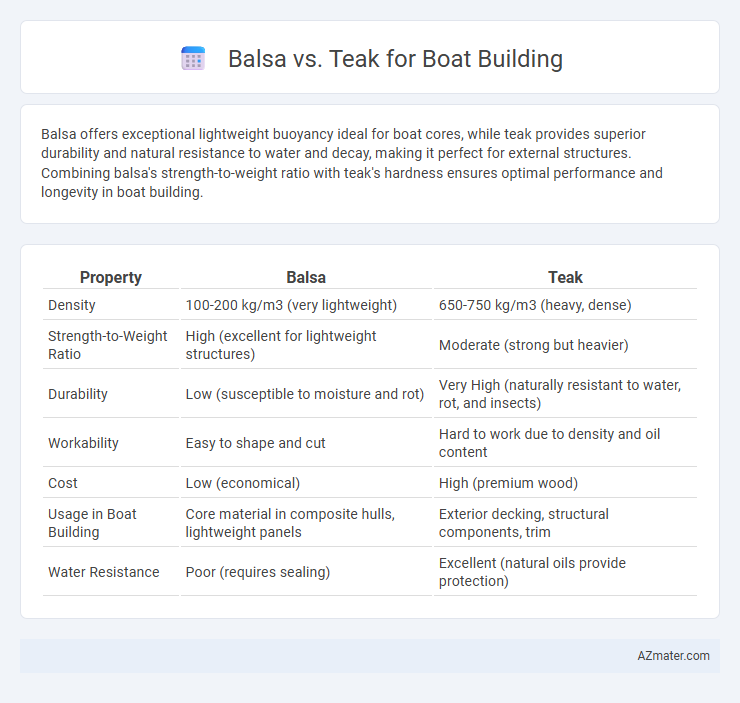Balsa offers exceptional lightweight buoyancy ideal for boat cores, while teak provides superior durability and natural resistance to water and decay, making it perfect for external structures. Combining balsa's strength-to-weight ratio with teak's hardness ensures optimal performance and longevity in boat building.
Table of Comparison
| Property | Balsa | Teak |
|---|---|---|
| Density | 100-200 kg/m3 (very lightweight) | 650-750 kg/m3 (heavy, dense) |
| Strength-to-Weight Ratio | High (excellent for lightweight structures) | Moderate (strong but heavier) |
| Durability | Low (susceptible to moisture and rot) | Very High (naturally resistant to water, rot, and insects) |
| Workability | Easy to shape and cut | Hard to work due to density and oil content |
| Cost | Low (economical) | High (premium wood) |
| Usage in Boat Building | Core material in composite hulls, lightweight panels | Exterior decking, structural components, trim |
| Water Resistance | Poor (requires sealing) | Excellent (natural oils provide protection) |
Introduction to Balsa and Teak in Boat Building
Balsa wood is prized in boat building for its exceptionally low density and high strength-to-weight ratio, making it ideal for lightweight core materials in composite hulls. Teak is renowned for its durability, natural oils, and resistance to water damage, making it a preferred choice for decking and exterior trim where exposure to harsh marine environments is frequent. The combination of balsa's lightweight core with teak's robust, weather-resistant properties provides a balanced approach in wooden boat construction.
Key Characteristics of Balsa Wood
Balsa wood is renowned for its exceptional lightweight and high strength-to-weight ratio, making it an ideal core material in boat building for enhanced buoyancy and structural performance. Its porous, fine-grained texture allows for excellent bonding with epoxy resins and fiberglass, creating a durable composite hull that resists water absorption and rot. The low density of balsa wood significantly reduces the overall weight of the vessel, contributing to improved fuel efficiency and speed without compromising strength.
Key Characteristics of Teak Wood
Teak wood is highly valued in boat building for its exceptional durability, natural water resistance, and high oil content, which protects against rot and marine organisms. Its dense grain structure provides strength and stability, making it ideal for structural components and decking. Teak's ability to withstand harsh marine environments without warping or cracking sets it apart from softer woods like balsa.
Strength and Durability Comparison
Teak offers superior strength and exceptional durability due to its dense grain and natural oils, making it highly resistant to rot, water damage, and insect infestation, which is crucial for boat building in harsh marine environments. Balsa, while extremely lightweight and providing excellent buoyancy, lacks the structural strength and long-term durability of teak, often requiring encapsulation or laminating with stronger materials for effective use. The choice between balsa and teak depends largely on balancing weight considerations with the need for a robust, long-lasting hull capable of withstanding prolonged exposure to saltwater and mechanical stress.
Weight Differences: Balsa vs Teak
Balsa wood is significantly lighter than teak, with a density averaging around 160 kg/m3 compared to teak's 660-750 kg/m3, making balsa a preferred core material in sandwich construction for weight reduction. The lightweight nature of balsa enhances buoyancy and fuel efficiency in boat building, while teak's higher density contributes to superior strength and durability. Choosing between balsa and teak depends on balancing weight constraints and structural requirements in marine applications.
Resistance to Water and Rot
Teak exhibits exceptional resistance to water and rot due to its high natural oil content and dense grain structure, making it ideal for boat building in marine environments. Balsa, while extremely lightweight and buoyant, has low natural resistance to water and rot and typically requires thorough sealing and treatment to withstand prolonged exposure to moisture. Teak's durability and ability to withstand harsh conditions without significant degradation make it a preferred choice over balsa for structural components subject to constant wetness.
Maintenance Requirements
Balsa wood requires minimal maintenance due to its lightweight and natural resistance to rot when properly sealed, but its softness demands frequent inspections to prevent damage. Teak offers exceptional durability and natural oils that repel water and pests, significantly reducing maintenance efforts over time. Regular cleaning and application of teak oil enhance teak's longevity, while balsa cores often need careful sealing to maintain structural integrity in marine environments.
Cost and Availability
Balsa wood is significantly more affordable and readily available compared to teak, making it a cost-effective choice for boat core construction. Teak, known for its durability and water resistance, commands a higher price and can be harder to source due to sustainable harvesting restrictions. Builders often select balsa for lightweight structures while reserving teak for exterior trim where aesthetics and durability are paramount.
Ideal Applications for Balsa and Teak
Balsa wood is ideal for boat building applications requiring lightweight core materials, such as sandwich construction in hulls and decks, due to its exceptional strength-to-weight ratio and buoyancy. Teak excels in areas exposed to weather and water, like decking, trim, and cabinetry, thanks to its natural oils, durability, and resistance to rot and marine organisms. Choosing balsa core composites enhances performance and fuel efficiency, while teak ensures longevity and aesthetic appeal in visible, high-wear parts.
Choosing the Right Wood for Your Boat
Balsa wood is favored in boat building for its lightweight and excellent buoyancy, making it ideal for core materials in composite hulls, while teak is prized for its durability, natural resistance to rot and marine organisms, and beautiful grain, commonly used for decking and trim. Selecting the right wood depends on the boat's purpose: balsa offers superior strength-to-weight ratio for speed and performance, whereas teak provides long-lasting structural integrity and aesthetic appeal in harsh marine environments. Balancing these properties ensures optimal performance and longevity tailored to the vessel's specific needs.

Infographic: Balsa vs Teak for Boat Building
 azmater.com
azmater.com